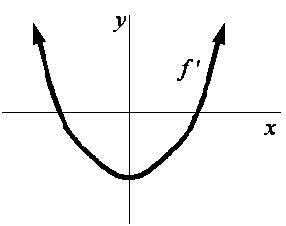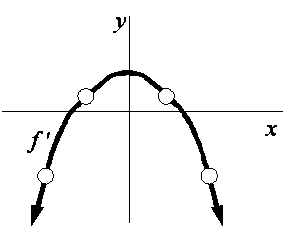|
Honors AP Calculus / Mr. Hansen |
Name: _______________________________ |
|
10/8/2009 |
READ INSTRUCTIONS IN EACH PART!
______ |
Test #2 (100 points): No Calculator Allowed
|
|
Part I: Mathematician Matching (2 points each, no
partial credit) |
||
|
|
|
||
|
___1. |
G๖del |
A. Faced a
bitter rivalry with Newton over the issue of who had developed the calculus
first |
|
|
___2. |
Weierstrass |
B. His name
is attached to a self-similar set formed by removing the middle third from a
line segment (usually the interval [0, 1]) and then recursively removing each
middle third from the segments that remain |
|
|
|
|
C. Noted for
the snowflake curve, a self-similar curve having finite area but infinite
perimeter |
|
|
|
|
D. Shook the
foundations of mathematics with his famous Incompleteness Theorem
approximately 80 years ago. |
|
|
|
|
E. The only one of the six mathematicians listed here who is still
alive |
|
|
___6. |
Cantor |
F. Noted for
defining a bizarre function that is continuous everywhere but differentiable
nowhere |
|
|
|
|
|
|
|
|
Part II: Multiple Choice (3 points each, no partial
credit, no penalty for guessing) |
||
|
|
|
||
|
___7. |
Is the graph of the
function mentioned in F above a fractal? |
||
|
|
(A) yes, because the function is differentiable |
(D) no, because the function is not differentiable |
|
|
|
(B) yes, because self-similarity is evident |
(E) no, because self-similarity is not evident |
|
|
|
(C) yes, because it is the Mandelbrot set |
|
|
|
|
|
||
|
___8. |
Most cellular telephones
include what application of fractals? |
||
|
|
(A) fractal transmission patterns |
(D) fractal noise |
|
|
|
|
|
|
|
___9. |
In mathematics, the term parameter means . . . |
|
|
|
|
(A) a boundary |
(D) a constant |
|
|
|
(B) the perimeter of a boundary |
(E) an adjustable constant |
|
|
|
(C) a variable |
|
|
|
|
|
||
|
___10. |
In the formal definition of |
||
|
|
(A) An open
interval is not a neighborhood of a point. |
||
|
|
(B) There is
no good reason; an open interval would work just as well as a punctured |
||
|
|
(C) The
question is posed incorrectly. The formal definition of limit requires the
function values to lie within a punctured |
||
|
|
(D) We wish our definition to make no requirement that f (c)
exists. |
||
|
|
(E) The
question is posed incorrectly. The formal definition of limit requires the
function values to lie within a punctured |
||
|
|
|
||
|
___11. |
When it comes to factual
knowledge, most human beings . . . |
||
|
|
(A) greatly underestimate how much they know |
||
|
|
|
||
|
|
Part III. Fill in the Blanks (9 points) |
||
|
|
|
||
|
12. |
Would Mr. Hansen say that arguing
about math problems and solution procedures is a good way to learn? ___ Why
or why not? _________________________________________________ |
||
|
|
|
||
|
|
Part IV. Problems (9 points each) |
||
|
|
|
||
|
13. |
State the definition of
derivative, and use the definition to compute |
||
|
|
|
||
|
|
|
||
|
|
|
||
|
|
|
||
|
|
|
||
|
|
|
||
|
|
|
||
|
|
|
||
|
|
|
||
|
|
|
||
|
|
|
||
|
|
|
||
|
|
|
||
|
|
|
||
|
|
|
||
|
|
|
||
|
|
|
||
|
|
|
||
|
|
|
||
|
|
|
||
|
|
|
||
|
|
|
||
|
14. |
Let |
|
|
|
|
(a) |
Prove that f is
not continuous at x = 2 if a = 10. |
|
|
|
|
|
|
|
|
|
|
|
|
|
|
|
|
|
|
|
|
|
|
|
|
|
|
|
|
|
|
|
|
|
|
(b) |
Find the value of a that would
make f continuous at x = 2. |
|
|
|
|
|
|
|
|
|
|
|
|
|
|
|
|
|
|
|
|
|
|
|
|
|
|
|
|
|
|
|
|
|
|
|
|
|
|
|
|
|
|
|
15. |
Let g(x) = 3x. Given: g is differentiable on
|
|
|
|
|
(a) |
What kind of function is g? Circle all that apply: exponential power polynomial trigonometric |
|
|
|
|
(b) |
Prove, rigorously, that
since 32 = 9 and 33 = 27, there exists a value of x such that 3x = 10. What are the bounds on x? |
|
|
|
|
|
|
|
|
|
|
|
|
|
|
|
|
|
|
|
|
|
|
|
|
|
|
|
|
|
|
|
|
|
|
|
|
|
16-19. |
For each graph of |
|
|
|
|
16. |
|
|
|
|
|
17. |
|
|
|
|
|
18. |
|
|
|
|
|
19. |
|
|
|
|
|
|
Part V. Very Silly Part (2 points) |
|
|
|
|
20. |
What does Mr. Hansen have
in common with the Knights Who Say Ni? |
|
|
|
|
|
________________________________________________________________________ |
|
|
|
|
|
________________________________________________________________________ |
|
|
|
|
|
Part VI. Leftover Part (required for homework; did not make the cut for
the in-class test) |
|
|
|
|
21. |
Prove that if ~P does not imply Q, then P and Q are both false. Show all steps, but
you do not need to provide a reason for each step. |
|
|
|
|
|
|
|
|
|
|
|
|
|
|
|
|
|
|
|
|
|
|
|
|
|
|
|
|
|
|
|
|
|
|
|
|
|
|
|
|
|
|
|
|
|
|
|
|
|
|
|
|
|
|
|
|
|
|
|
|
|
|
|
|
|
|




